Home Gym Ideas: Building Your Dream Home Gym
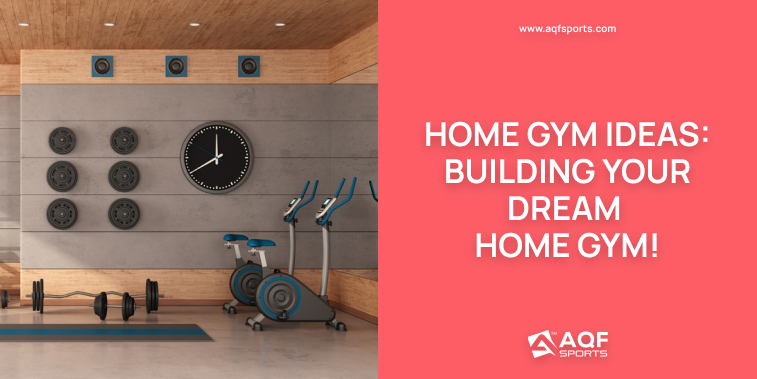
Are you tired of crowded gyms and expensive memberships? Building a home gym is a convenient, cost-effective and more accessible solution. A home gym allows you to tailor your workouts to your preferences and exercise at your convenience. Let’s plore the essential home gym ideas you can use to start building your home gym in your basement, spare room, garage, or any small space.
Getting Started: Tips to Design Your Home Gym Space
Define Your Workout Space
a. Assess the available area:
Determine the size and layout of your workout space to understand its limitations and possibilities.
b. Consider natural lighting:
Utilize natural light sources or install adequate lighting fixtures to ensure a well-lit and energizing environment.
c. Maintain proper ventilation:
Ensure good air circulation and temperature control to create a comfortable workout area.
Identify Your Fitness Goals
a. Set clear objectives:
Define your fitness goals, such as weight loss, strength training, or improving flexibility, to tailor your workout space accordingly.
b. Visualize your ideal workout environment:
Imagine the atmosphere, colors, and ambiance that will motivate you to stay consistent and focused on your fitness journey.
Gather Home Gym Ideas
a. Explore inspiration sources:
Research online platforms, fitness magazines, and social media for home gym ideas, designs, and innovative equipment arrangements.
b. Create a vision board:
Collect images, colors, and design elements that resonate with your personal style and fitness aspirations.
Optimize Your Workout Area
a. Flooring considerations:
Choose appropriate flooring that is comfortable, shock-absorbent, and easy to clean, such as rubber, foam, or vinyl tiles.
b. Mirrors for form and motivation:
Install mirrors strategically to check your form during exercises and create a sense of spaciousness while boosting motivation.
c. Sound system setup:
Invest in a quality sound system or speakers to enjoy uplifting music or motivational workout playlists, creating an immersive and energizing atmosphere.
Incorporate Innovative Storage Solutions
a. Utilize wall space:
Install wall-mounted shelves or racks to store smaller fitness accessories, such as resistance bands, yoga straps, or hand weights.
b. Multi-functional furniture:
Opt for furniture pieces that double as storage units, like ottomans or benches with hidden compartments for storing larger equipment or workout gear.
c. Vertical storage options:
Utilize vertical storage solutions, such as tall cabinets or wall-mounted pegboards, to maximize space and keep larger equipment organized and easily accessible.
Safety First
Safety should be a top priority in your home gym. Ensure that all equipment is in proper working condition and regularly check for any signs of wear and tear. Invest in suitable flooring to provide cushioning and protect against potential injuries. If needed, consult a professional to ensure proper installation of heavy equipment like squat racks or pull-up bars.
Home Gym Ideas: Space Selection
Creating a home gym offers the convenience and flexibility to work out whenever you please. The first step in building your dream fitness space is finding the perfect spot within your home.
Assess Available Space
a. Spare Room:
If you have an unused bedroom, guest room, or an underutilized space, converting it into a home gym could be a perfect solution. It offers privacy and allows you to dedicate an entire room solely to your workouts.
b. Basement:
Transforming your basement into a gym is a popular choice due to its ample space and seclusion from the rest of the house. It provides a blank canvas to design your ideal workout environment.
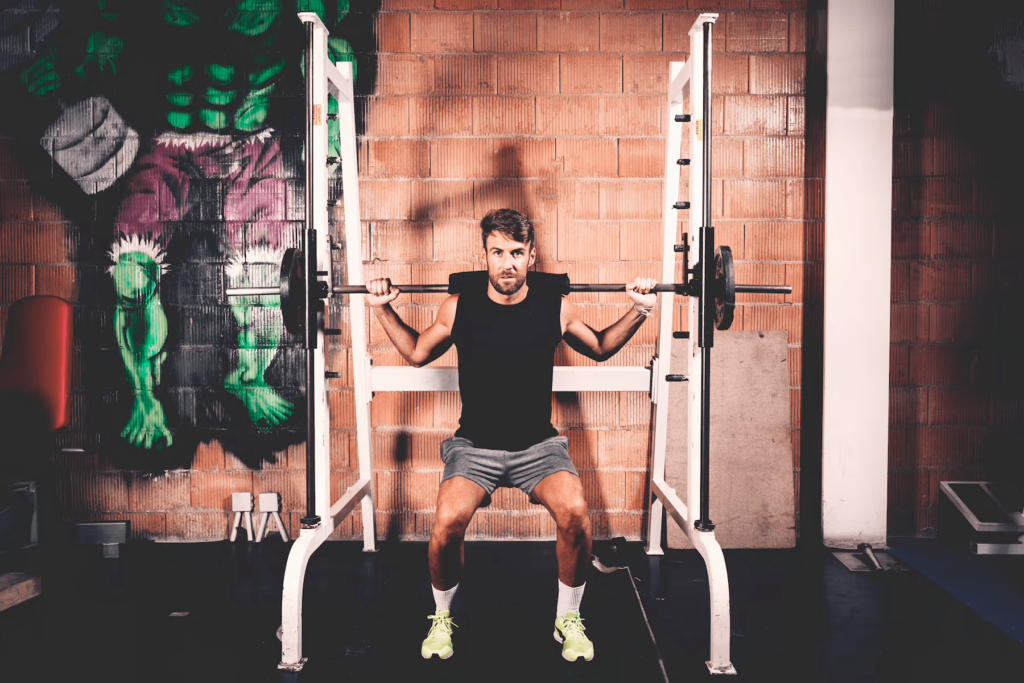
c. Garage:
If you have a spacious garage that is not being fully utilized, consider repurposing it into a gym. This option allows you to enjoy natural light and fresh air while providing enough room for equipment and workout routines.
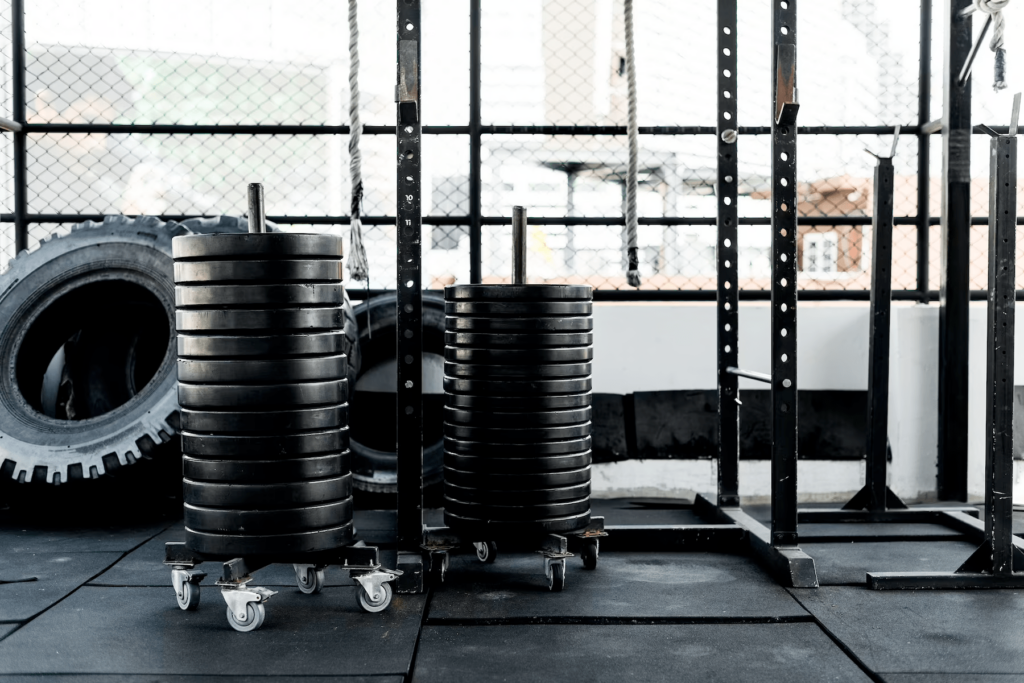
d. Corner of a Room:
If you’re working with limited space, you can carve out a dedicated workout area in a corner of a room. This option is ideal for smaller homes or apartments where every square foot matters.

Consider Practicality
a. Accessibility:
Choose a location that is easily accessible and doesn’t require you to navigate through multiple rooms. This convenience will motivate you to work out more consistently.
b. Noise Level:
Consider the noise generated during your workouts. If possible, select a spot that won’t disturb other members of the household or neighbors.
c. Ventilation:
Ensure the chosen space has adequate ventilation or the ability to install proper ventilation systems to maintain a comfortable workout environment.
Evaluate Environmental Factors
a. Natural Light:
If possible, select a spot with ample natural light to create an energizing and uplifting atmosphere. Large windows or skylights can contribute to a pleasant workout experience.
b. Flooring:
Choose a location with a suitable flooring surface that can withstand the impact of workouts and is easy to clean. Options include rubber mats, foam tiles, or hardwood floors with protective coverings.
Customize and Optimize
a. Personalize the Space:
Add motivational posters, inspiring artwork, or a vision board to infuse your personality and keep you motivated during workouts.
b. Efficient Equipment Placement:
Optimize the space by carefully planning the arrangement of your equipment. Consider wall-mounted storage solutions or compact multi-functional equipment to maximize floor space.
Home Gym Ideas: Equipment
Designing a home gym that meets your fitness needs and goals requires careful consideration of the essential equipment. Whether you’re a seasoned fitness enthusiast or just starting your fitness journey, having the right tools in your home gym can make all the difference.
Gym Essentials: Laying the Foundation for your Home Gym
a. Dumbbells or Adjustable Weights:
Versatile and effective for strength training, dumbbells or adjustable weights allow you to target different muscle groups with varying resistance levels.
b. Resistance Bands:
Compact and adaptable, resistance bands offer resistance for strength and flexibility training, making them ideal for at-home workouts.
Related Read: 13 Mini Resistance Bands Exercises for Beginners
c. Exercise Mat:
An exercise mat provides cushioning and support during floor exercises, stretching routines, and yoga sessions, ensuring your comfort and safety.
Must-Have Home Gym Equipment
a. Treadmill or Stationary Bike:
Perfect for cardiovascular workouts, a treadmill or stationary bike enables you to engage in effective indoor cardio sessions, regardless of the weather.
b. Multifunctional Home Gym System:
These versatile systems combine multiple exercise stations, such as pulleys, cables, and weight stacks, offering a wide range of strength training exercises within a single unit.
c. Adjustable Bench:
An adjustable bench provides a stable surface for exercises like bench presses, step-ups, and seated dumbbell workouts, adding versatility to your training routine.
DIY Gym Equipment: Cost-Effective Options for Expanding Your Home Gym
a. Plyometric Box:
Constructing a sturdy plyometric box allows you to perform explosive exercises like box jumps and step-ups, enhancing your lower body strength and power.
b. Medicine Ball:
Creating a medicine ball by filling a durable bag with sand or rice provides a versatile tool for dynamic strength and conditioning exercises.
c. Pull-Up Bar:
Installing a pull-up bar in a doorframe or using a wall-mounted option helps develop upper body and core strength, allowing you to perform challenging bodyweight exercises.
Targeted Gym Equipment for Specific Training Goals
a. Squat Racks and Power Cages:
Essential for barbell squats, bench presses, and other compound movements, squat racks and power cages offer safety and stability during heavy lifts.

b. Weight Plates and Barbells:
These foundational tools for strength training allow you to progressively overload your muscles, promoting strength and muscle development.
c. Punching Bag:
A punching bag is ideal for boxing or kickboxing workouts, enabling you to enhance endurance, coordination, and overall fitness while providing a stress-relieving outlet.
Additional Gym Equipment to Enhance Your Workouts
a. Yoga Mat:
A comfortable and non-slip yoga mat is essential for practicing yoga, Pilates, or engaging in floor exercises, fostering flexibility, balance, and core strength.
b. Skipping Rope:
An affordable and effective cardiovascular tool, a skipping rope offers a high-intensity workout while improving coordination and endurance.
Home Gym Ideas: Workouts
You can perform gym workouts within the comfort of your home gym. Here are some examples of effective home gym workouts that target different muscle groups and fitness goals:
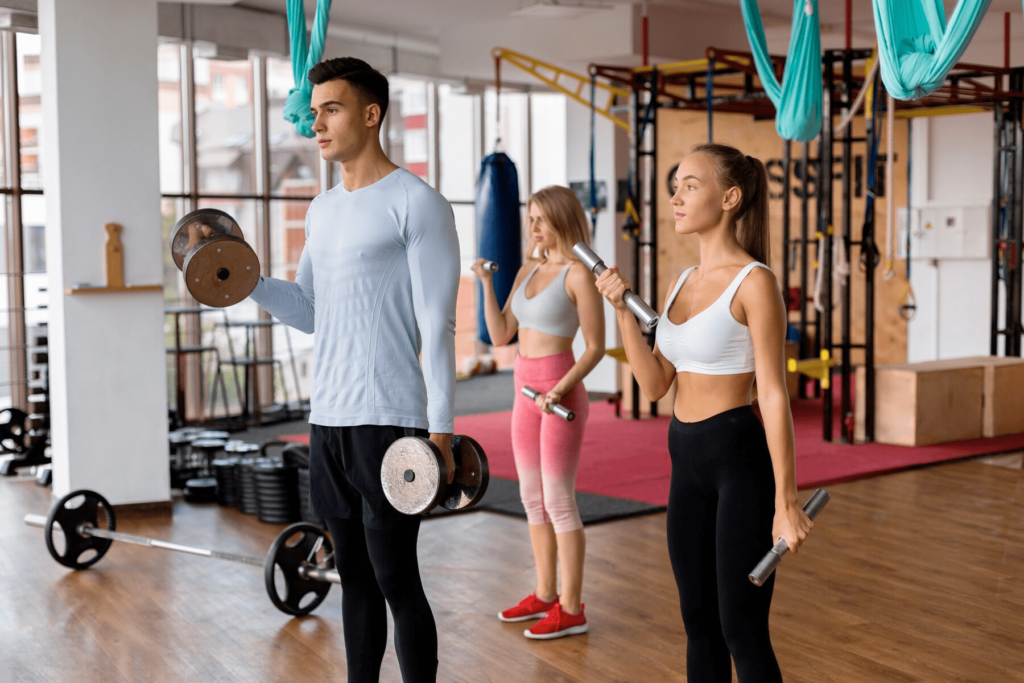
Full-Body Circuit:
- Jumping jacks
- Push-ups
- Squats
- Plank
- Mountain climbers
- Dumbbell bicep curls
- Lunges
- Russian twists
- Burpees
- Tricep dips
Cardio HIIT Workout:
- Jumping rope
- High knees
- Jump squats
- Burpees
- Mountain climbers
- Bicycle crunches
- Jumping lunges
- Plank jacks
- Skater hops
- Sprint intervals (running in place)
Upper Body Strength:
- Push-ups (standard, wide, or close grip)
- Dumbbell chest press
- Bent-over rows
- Shoulder press
- Tricep dips (using a bench or chair)
- Bicep curls
- Pull-ups or assisted pull-ups
- Plank with alternating arm lifts
- Push-up to side plank
Lower Body Strength:
- Squats (bodyweight or weighted)
- Lunges (forward, reverse, or side)
- Bulgarian split squats
- Deadlifts (using dumbbells or kettlebells)
- Glute bridges
- Calf raises (bodyweight or with weights)
- Step-ups (using a bench or sturdy platform)
- Wall sits
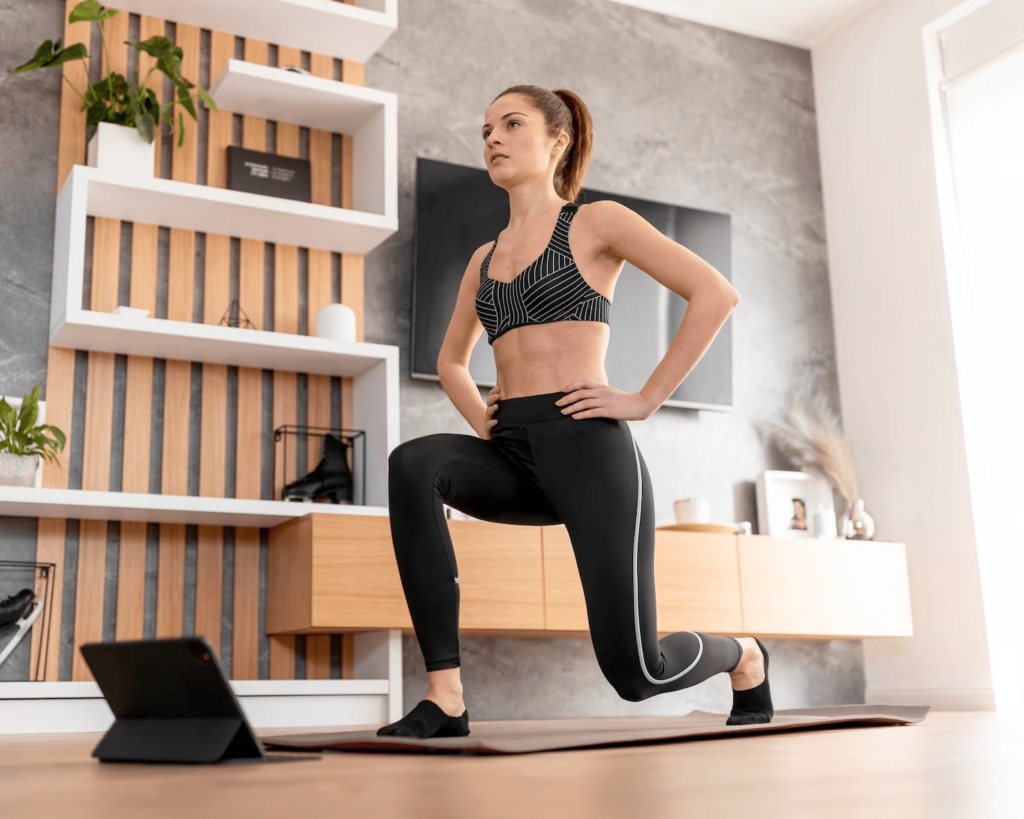
Core and Abs:
- Bicycle crunches
- Plank variations (forearm plank, side plank, plank with leg lifts)
- Russian twists (with or without weights)
- Reverse crunches
- Flutter kicks
- Mountain climbers
- Woodchoppers (using a resistance band or dumbbell)
- Leg raises
- Side plank dips
How to Design Effective Home Workouts?
a. Create a structured routine:
Plan your workouts in advance, scheduling specific days and times for different muscle groups or types of workouts. This helps maintain consistency and ensures you cover all aspects of fitness.
b. Circuit training:
Combine multiple exercises targeting different muscle groups into a circuit. Perform each exercise for a set time or number of repetitions, moving from one exercise to the next without rest. This method maximizes efficiency and calorie burn.
c. High-intensity interval training (HIIT):
Incorporate HIIT workouts, alternating between short bursts of intense exercise and brief periods of rest. HIIT workouts are time-efficient and effective for cardiovascular fitness and calorie burning.
d. Online workout resources:
Access online platforms, fitness apps, or home workout videos that provide guided routines and exercises specifically designed for small home gyms. These resources offer variety and guidance in your workout journey.
Home Gym Ideas: FAQs
What do I need for a home gym UK?
For a home gym in the UK, you’ll need exercise equipment like dumbbells or resistance bands, a workout mat, storage solutions, and a well-ventilated space.
How do I set up a perfect home gym?
Set up a perfect home gym by selecting suitable equipment, optimizing the space with storage solutions, ensuring proper lighting and ventilation, and creating a motivating environment.
How much does it cost to set up a home gym?
The cost of setting up a home gym varies based on personal preferences and budget, ranging from a few hundred pounds to several thousand, depending on equipment and accessories.
Are home gyms worth it?
Yes, home gyms are worth it for many people due to convenience, flexibility, and long-term cost savings compared to gym memberships.
Is it cheaper to go to a gym or make a home gym?
In the long run, a home gym can be cheaper than a gym membership since you don’t have monthly fees. However, the initial investment in equipment should be considered.
What is a good size room for a home gym?
A good size room for a home gym depends on your specific needs, but generally, a space of around 100-200 square feet can accommodate various types of workouts.
How do I start a gym at home for beginners?
To start a home gym for beginners, begin with basic equipment like dumbbells or resistance bands, set up a designated workout area, establish a routine, and gradually increase intensity and equipment as you progress.
Conclusion
Transform your home into a powerhouse of fitness with creative workouts, personalized spaces, and effective equipment. From building a home gym to designing the perfect workout area, we’ve covered it all. Unleash your potential, achieve your goals, and elevate your fitness journey at home. Get started today!
Related Links:
- 12 Fat Burning Exercises to Loose Weight at Home
- 30 Minute Cardio Workout at Home – AQF Sports
- Crash Course on Basic Martial Arts Training at Home
Image Source: Freepik






